Table of Contents
Toggle|
First Submitted |
3 Oct. 2022 |
Updated Released |
29 March 2023 |
26 Feb. 2024 |
|
Abstract:
There is no clear information on the completion date of China’s plan to unify Taiwan, but many indications are that China’s unification plan was formulated in 2012. In 2013, the Chinese president publicly and formally pledged that Taiwan’s reunification would be completed during his term. In 2019, Chinese state media vaguely but firmly pointed to Taiwan’s deep involvement in the anti-return riots in Hong Kong. Mainland people’s opposition to the Taiwan authorities’ “betrayal of the country” has reached its peak. This is the main reason why some observers predict that China will withdraw its commitment to make political concessions to Taiwan. On 1 July 2021, for the first time at a major event, mainland China referred only to “one country” and did not mention Taiwan’s “two systems”. On 10 August 2022, the mainland central government officially announced that Taiwan had essentially lost the political benefits of “one country, two systems”. In other words, the Taiwan authorities have no military control and no diplomatic power. Senior administrative officials must support the mainland and accept supervision by the central government. The central government still leaves room for Taiwan’s administration to negotiate government structures, economic systems and tax incentives. Many factors will close the window for peace negotiations in 2026, leaving Taiwan with about three years of buffer time. If reunification is initiated later than 15 September 2026, Xi Jinping runs the risk of his great achievements being shared, misinterpreted, misrepresented,distorted and downgraded.
Keywords:
Unification; Cross-Strait Relations; One Country, Two Systems; 2026; Sino-US Conflict; Land-based Weapon; Sea-based Weapon; Weapon Effective Range; Anti-ship Missile. Europe; Uncertainty.
Subdirectory:
- In 2012, the plan for the reunification of Taiwan had takenfull shape.
- In 2013, the plan for the reunification of Taiwan was officially announced.
- In 2019, mainland public opinion was against peaceful reunification.
- In 2019, civilian found signs that the mainland was withdrawing politics favor of “two systems”.
- On 1 July 2021, mainland officials released signs that “two systems”is getting away.
- On 10 August 2022, Taiwan lostthe essence of “two systems” favor.
- Future, Taiwan will have no motivation to initiate peace talks.
7.1. Taiwan has erected a strong anti-unification barrier.
7.2. Taiwan loses its rationality to judge the international situation
- Future, Mainland China will have no motivation to initiate peace talks.
8.1. In the scenario of a Sino-US conflict in 2026, the United States faces major shortcomings.
8.2. The advantage of land power in war is returning or has returned to the stage of history.
8.3. Peaceful unification can severely limit China’s geopolitical gains.
8.4. Peaceful operations will seriously consume China’s governance costs.
8.5. Peaceful unification will seriously slow China’s historical pace down.
- In 2026, the unification and two driving factors.
9.1. The United States cannot calm the chaos in Europe.
9.2. Many countries are ready to join the process of dismantling European power.
9.3. Russia has targeted the L1 line as its new national security frontier
9.4. New needs will actively seek their leaders and windows to embody their needs.
9.5. The rise of land power needs a window to show off.
9.6. China’s real needs
9.7. China’s historical needs
- Probability of lead or lag
I. 2012, Unifying Taiwan Plan Shaped
When Looking back at Xi Jinping’s political experience from 2010 to 2012, it can be seen that the plan to unify Taiwan helped him escape the political quagmire.It was Xi Jinping who found this force powerful enough to defeat his political enemies. He discovered this resource and took advantage of it. Under the banner of reunifying Taiwan, he collected other scattered political resources in China to form his own political force. It was Xi Jinping who, for the first time, put forward a complete and systematic plan to regain Taiwan. It was this plan that gave Xi Jinping greatest political appeal. With the banner of China’s unification, Xi formed the most powerful political power group at that time. All of these supported Xi to gain the initiative in the political struggle against the Jiang Zemin clique and the Hu Jintao clique. The following points can support this hypothesis.
1.1 Xi Jinping once fell into political trouble.
Table 1 below briefly outlines the process by which Xi Jinping had traped into political crisis and eventually reversed the unfavourable situation. Launching a complete plan to unify Taiwan (including an forced reunification plan) is Xi Jinping’s ultimate weapon to win the political struggle.
|
Table 1: Important political resume of Xi Jinping (by 2012) |
|
|
Military background |
1979 to 1982, he worked in the Central Military Commission of the Communist Party of China, serving as assistant secretary to Geng Biao, Secretary-General of the Military Commission. He is intimately familiar with the operation procedures of China’s military command system. |
|
Senior cadre of the Communist Party of China |
2000 to 2002, he was the Deputy Secretary of the Fujian Provincial Party Committee and the Governor of the Fujian Province; the Deputy Secretary of the Zhejiang Provincial Party Committee and the Acting Governor of Zhejiang Province. A period of rapid political development for him. |
|
Important member of Jiang Zemin Group |
2002 to 2007, he was the Secretary of the Zhejiang Provincial Party Committee. Just two years after becoming a governor, he was promoted to a Party Secretary of a major province. An extremely rare case of rapid advancement for any Chinese officer. |
|
Core member of Jiang Zemin Group |
In 2007, he was appointed the Secretary of the Shanghai Municipal Party Committee. After five years as the Secretary of the Zhejiang Provincial Party Committee, he was promoted to the Secretary of the Shanghai Municipal Party Committee, proving that Xi Jinping had officially become a core member of the next generation leaders selected by the Jiang Zemin group. |
|
Officially became “Crown Prince” |
From 2007 to 2012, he became a member of the Standing Committee of the Political Bureau of the CPC Central Committee. He skipped the rank of Politburo member and jumped directly from a member of the Central Committee to a member of the Standing Committee of the Political Bureau of the CPC Central Committee. This fact officially confirms that Xi Jinping will be the next General Secretary of CPC and the President-in-waiting. |
|
Postponing his appointment as Vice Chairman of the Central Military Commission |
In 2009, there were online rumor that Xi Jinping himself had asked to postpone to appoint him as Vice Chairman of the Central Military Commission of CPC. The official explanation was that ‘there is no discussion on the appointment of a vice chairman of the military commission at present’. |
|
Rumors of coup d’état |
Throughout 2010 and 2011, rumours circulated online that Xi Jinping was facing a political crisis and had been abandoned by Jiang Zemin’s clique. He might be replaced by another political star, Bao Xilai. In 2014 and 2015, semi-official sources confirmed that Xi Jinping had indeed traped in a political crisis. |
In 2002, Xi Jinping and Bo Xilai were elected to the CPC Central Committee at the same time that means both of they were at same political level in CPC ranking system. In 2007, Bo Xilai was promoted to a member of the Political Bureau of the CPC Central Committee. Xi Jinping skipped this level and was promoted directly to the Standing Committee of the Political Bureau of the CPC Central Committee. He was recognised as the President-in-waiting. At this stage, Xi Jinping is considered a core member of Jiang Zemin’s political group and the core of the next generation leaders.
In 2009, following the normal trajectory of Chinese politics, Xi Jinping was expected to take over as Vice Chairman of the Central Military Commission this year or earlier. However, there was online rumor that “Xi Jinping initiatively wrote a letter requesting a delay for this appointment”. The official response to this online rumour was that “there is currently no discussion on the appointment of the Vice Chairman of the Military Commission”. The popular interpretation of this incident is that Xi Jinping has been banned. Opposition could come from Hu Jintao’s clique, Jiang Zemin’s clique, or from both.
From 2007 to 2011, Bo Xilai, another political star in Jiang Zemin’s group, had a more prominent position in the political arena than Xi Jinping. From 2010 to 2011, there were online rumours that Xi Jinping might be abandoned by Jiang Zemin’s clique. Bo Xilai could replace him politically.
In several official propaganda campaigns in 2014 and 2015, some senior CCP officials publicly confirmed that a “coup plot” had taken place but failed. It confirmed that Xi Jinping had been traped into a dark period, and been blocked by both Jiang Zemin’s clique and Hu Jintao’s clique.
1.2 Xi Jinping suddenly shows strength and powerful offensive power
As the Wen Jiabao Group joined the melee, Xi Jinping began a series of firm and tough counterattacks.
|
Critical Moment |
On 14 March 2012, Xi’s political opponents were besieged by the Wen Jiabao group. |
|
A sudden display of powerful power |
On 27 March 2012, the People’s Daily published an editorial entitled “Don’t leave difficulties to next shift“. 1. As Secretary-General-in-Waiting, publicly demand that the current Secretary-General “get the job done”. 2. Shows that Xi Jinping has formed an independent political force that can simultaneously challenge the two major political forces composed of the “current General Secretary Group” and the “former General Secretary Group”. 3. Directly shows that Xi Jinping has taken over China’s most powerful propaganda machine in advance. |
|
Showing Strength Again |
On 2 May 2012, the “People’s Daily” published an editorial entitled “Don’t back down before leaving office”. Publicly demanded current General Secretary Hu Jintao deal with the “Bo Xilai case” before the end of his term. |
|
Repeatedly Demonstrating Power |
On 18 May 2012, the People’s Daily published an editorial entitled “Finish the paving way before leaving office”. For the third time, it publicly put pressure on the Hu Jintao clique and also launched a challenge to the Jiang Zemin clique. |
|
Strong pressure on the Hu and Jiang groups |
In June and July 2012, many provincial Party newspapers across the country printed an interview report on their front pages. The title is “Finish tasks in the current term. Never leave jobs to successor “. 1. A decisive struggle, a comprehensive and open challenge to the two major political power groups. 2. A clear indication that Xi Jinping has taken over China’s powerful propaganda machine in advance. 3. This means that Xi Jinping has not only formed an independent political force, but also shows that this group has the strength and courage to openly challenge two powerful political factions at the same time. |
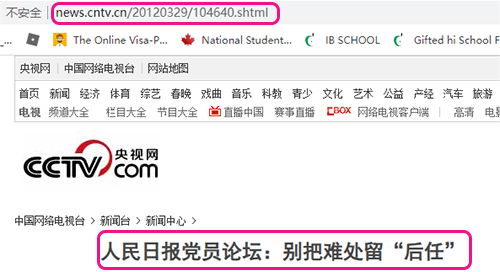
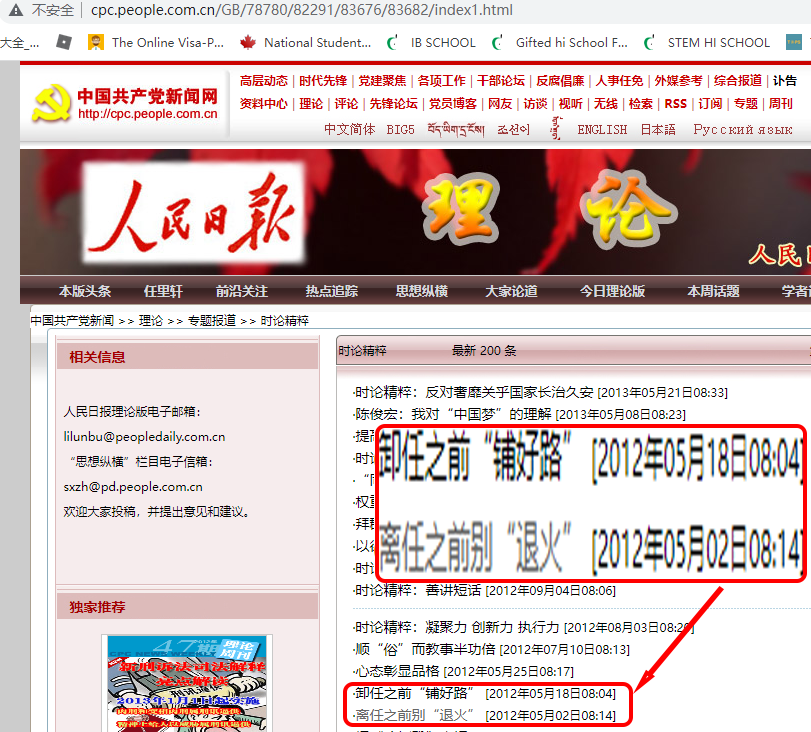
Figure1,2: China’s most powerful propaganda published a series of editorials unfavorable to the then-president.
From being a passive state facing deposition, Xi Jinping suddenly became a strong offensive state. This transformation is huge and risky.
Another unusual background is that Xi Jinping was an assistant to the then president Hu Jintao. Challenging your superior when you position as an assistant, that never has been the default state of East Asian culture. When Xi Jinping continuously made public accusations against his superiors through the public media, the situation is contrary to China’s cultural traditions. Such anti-tranditional behaviour typically weakens attacker politically and morally. In other words, without much enough power,no body attacks the opponent through a way of anti-cultural traditions.
It is an obvious fact that Xi Jinping not only did this, but also took an extremely tough stance. Dare to challenge two top political power groups at the same time. It proves that Xi Jinping had concentrated China’s powerful political resources in his hands at that time.
|
Decisive Victory |
22 September 2012, Bo Xilai was sentenced to life imprisonment. The Xi Jinping clique won the battle to challenge the two most powerful political blocs at the time. |
|
Strong Announcement 1: |
15 November 2012, the collective leadership of the 18th Central Committee of the CPC made its first public appearance. After Xi Jinping appeared alone on the side screen for five seconds, the other members of the team appeared one by one. Before taking the podium, the other members always kept a distance of about 2 metres from Xi Jinping. (It is a very clear statement. This leadership collective is not a republican mechanism, but a relationship between the central leader and his assistants). |
|
Strong announcement 2: |
The vice-president elected at the National People’s Congress after Xi Jinping took office does not have the status as a member of the Politburo Standing Committee, which clearly shows that this leadership team has no designated candidate for the crown prince. |
|
Tabulation: by Ye Qiquan (PPNet www.pppnet.net) |
|
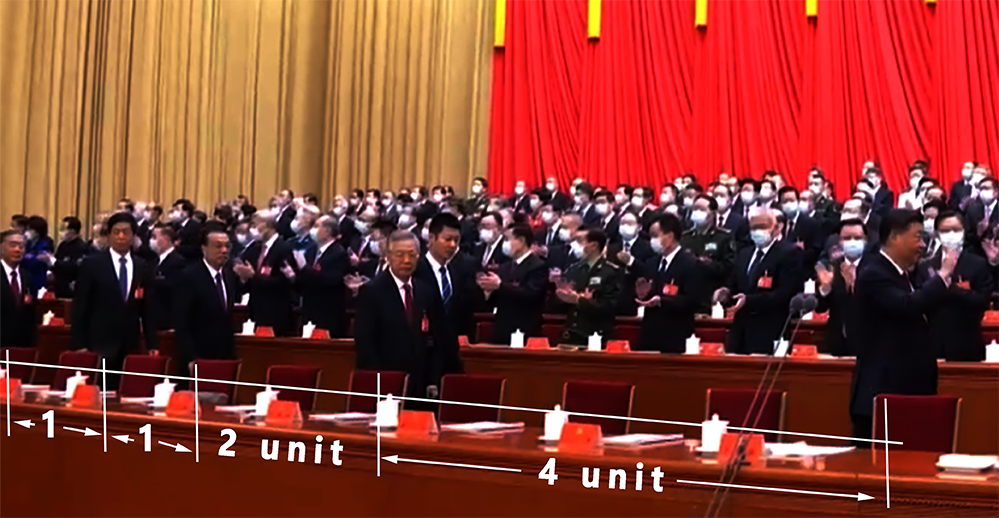
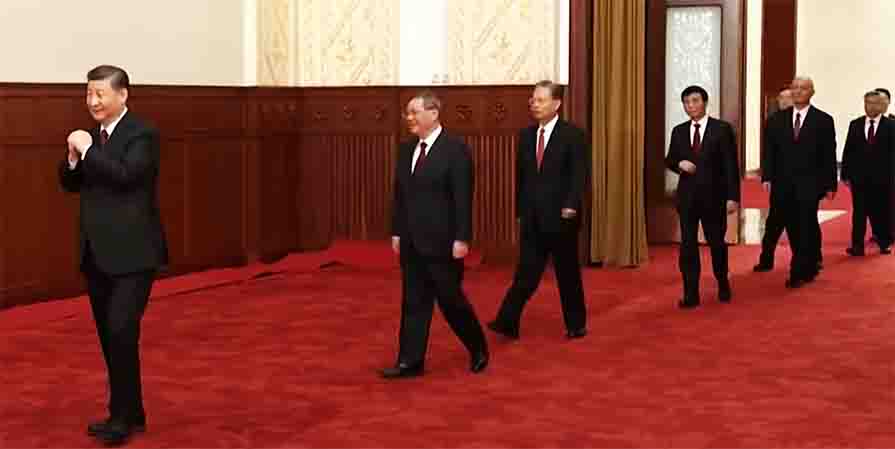
Figure 3,4: In the Jiang Zemin and Hu Jintao eras, leaders maintained the same spatial distance when they appeared together. Xi Jinping has changed this paradigm.
1.3 Xi Jinping has finally won this arduous political struggle.
On the table, the dispute appears to be between current officials and his successor over a job transition. But the truth beneath the surface is a Shakespearean drama.
Shakespeare’s play is simulated as follows:
Protagonists: Regent Prince: Jiang Zemin; Current King: Hu Jintao; Crown Prince: Xi Jinping; Premier-in-waiting: Li Keqiang; Coup Prince: Bo Xilai.
The current King, Hu Jintao, hoped that Li Keqiang become Crown Prince, but he failed, because he was weaker than the Regent Prince Jiang. In the end, Xi Jinping becames Crown Prince with the support from the Regent Jiang. Li Keqiang, a figure recommended by the current King Hu, took over as Premier-in-waiting. Of course, both of the King, Hu Jintao, and the Primer-in-waiting, Li Keqiang, were not happy with Xi Jinping and would do their best to stop Xi.
One day, the Regent Prince Jiang decides to abandon Xi Jinping and promote another star general, Bo Xilai, to replace Xi as the new Crown Prince.
Faced with the crisis, Crown Prince Xi Jinping quickly rallied his political group and army and captured star general Bo Xilai on the battlefield.
After capturing Bo Xilai, Xi Jinping threw him at the feet of the current King, Hu Jintao. He prayed: “Your Majesty, please kill this criminal. He has committed treason.”
Hu Jintao did not want to help Xi Jinping kill Bo Xilai, and he either did not want to offend the Regent Prince Jiang by killing Bo Xilai. He replied: “OK, no problem, we will try him in procedure.” But this procedure couldn’t be any slower.
On 27 March 2012, Xi Jinping could no longer stand the slow trial process. He galloped up to the King, Hu Jintao. Xi asked for instructions: “Please announce Bo Xilai’s crimes and then kill him. Not wanting to get involved in the grudge between them, Hu Jintao said: “No problem. No problem. As soon as we clearly investigate his crimes, I will kill him for you.”
On 2 May 2012, Xi Jinping was very concerned about the progress of the trial. He rode up to the King, Hu Jintao, and asked: “Please, Your Majesty, seek justice and kill those who rebelled.” Hu Jintao replied: “Absolutely, absolutely. It’s just that some crimes have not been clearly investigated. Once all the crimes are found out, the criminals will be executed immediately.”
On 18 May 2012, Xi Jinping could no longer contain his anger. He rode up to the King, Hu Jintao, and pleaded: “This man committed a crime during your reign. It is up to you to stand up and kill him” . Hu Jintao smiled: “You will be the king immediately. Then you can kill him. Even you will have no problem cutting him into 100 pieces. Xi Jinping replied: “No way, you cannot leave the work to me while you are in power.”
From June to July 2012, Xi Jinping never came to plead with Hu Jintao again. He was on horseback, standing in front of his army. He asked loudly: “Should the rebels be killed?” His troops were in an uproar, shouting “be killed, be killed”! The situation was chaotic.
Xi Jinping kept shouting to his troops. His troops chanted in unison, “Kill him! Kill him! Kill him!” Hu Jintao could no longer hold back. Regent Jiang Zemin had no choice either. So he told Hu Jintao: “Forget it! Kill him, kill him”.
On 22 September 2012, Hu Jintao announced to the army: “Bo Xilai has committed rebellion, be killed!”
On 15 November 2012, Xi Jinping ascended to the throne and Hu Jintao abdicated.
1.4 Decisive victory, not small victory
In the process of reversing the unfavourable situation, Xi Jinping has achieved not only a protective victory but also a comprehensive and overwhelming victory. There are three important signs.
(1) The political convention of the current president and the president-in-waiting being in office at the same time has been abandoned by Xi Jinping.;
(2) The number of members of the Standing Committee of the Political Bureau has been reduced from 9 to 7;
(3) The national decision-making system has changed from the co-governance system of the Politburo Standing Committee during the Hu Jintao era to a centralised leadership system.
1.5 What helped Xi is the public opinion to unify Taiwan only
Even during Hu Jintao’s 10 years in power, Jiang Zemin’s political clique still dominated China’s political direction. Experts and scholars who follow China’s political situation all recognise this fact.
Hu Jintao had been China’s president for 10 years, but it had been difficult to weaken the power of Jiang Zemin’s clique. As a figure who was abandoned by the original political group, Xi Jinping had great difficulties and risks in challenging the two most powerful political groups at the time.
China’s other major political forces have different identities, backgrounds, positions and interests. To unite these political forces (groups) in China, Xi Jinping must be able to discover or find common aspirations or common ideas that is strong enough to unite these scattered political forces in fist. Under the circumstances at that time, the most powerful public opinion and strongest political demand in China was the unification of Taiwan. This was the only power strong enough to survive Xi, to collect scattered political sources, to overcome the complex situation, and to defeat Jiang Group and Hu Group.
1.6 Proved the Unifying Taiwan Plan was formed in 2012
According to China’s political decision-making process, major decisions take at least 8 to 10 months or even longer. Eleven months after Xi Jinping came to power, he has formally made a political commitment to the Chinese people. He will complete the historic task of unifying Taiwan in the near future. It can be inferred that the political decision to unify Taiwan was proposed and initially formed in 2012. It may even have been made before Xi Jinping officially came to power.
A post-hoc analysis can safely conclude that China’s unification plan was formed in 2012. Xi Jinping emphasized that the unification of Taiwan will be completed during his tenure. This assessment is also the consensus view of current political science.
II. 2013, Unifying Taiwan Plan Announced Officially
2.1 First publicly announced at a foreign policy event.
When Chinese President Xi Jinping met with Taiwanese figure Vincent Siew (Xiao Wanchang, 蕭萬長, 萧万长), in Indonesia on 6 October 2013, he publicly stated that “the Taiwan issue cannot be handed down from generation to generation”[1].
2.2 Making formal public commitments to domestic audiences
Since the statement within diplomatic background issued on 6 October 2013, mainland China has confirmed it many times in the following four months. These repetitions and statements were released through authoritative channels, including state television broadcasts, Taiwan Affairs Office spokespersons and State Council spokespersons. Through these channels, Xi Jinping confirmed his commitment publicly. In China’s historical and political logic, formal political commitments are extremely serious historical events. When Chinese historians evaluate the status of a historical figure, they will mainly refer to the extent to which the historical figure fulfils his commitment. This big and serious commitment by Xi Jinping not only consolidates the foundation of his rule, but also brings enormous political pressure to bear on his rule.
III. 2019, Mainland Public Calls Forced Reunification
3.1. Calls Peaceful Unification Before 2016
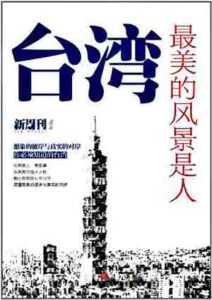
Figure 5: Mainland Chinese once enthusiastically followed everything in Taiwan
(This section does not discuss public opinion in Taiwan against One Country, Two Systems.)
Before 2016, the majority of public opinion on the mainland was to be friendly towards Taiwan. Although this general good intention has been one-sidedly opposed and negatively interpreted by Taiwan, the fact is that the military reunification of Taiwan is not supported by mainland public opinion.
- On 30 September 1981, Ye Jianying published “Ye’s Nine Points”. It promised that Taiwan would keep its militarytroops; keep its political and economical system; maintain a high degree of autonomy; the central government would not interfere in Taiwan’s affairs at all; maintain “foreign economic and cultural relations”with other countries; Taiwanese would have exclusive seats in the central government; the central government could subsidise Taiwan;
- On 25 June 1983, Deng Xiaoping elaborated on “Deng’s Six Points”. Taiwan can have an army; the mainland will not send anyone to Taiwan (military personnel will not go, nor will administrative personnel); the party, government, and military systems will be run by Taiwanese themselves; the central government will reserve exclusive leader seats for Taiwanese; administrative independence, judicial independence, and final decision-making will not have to go to Beijing.
- Former Chinese PresidentsJiang Zemin and Hu Jintao have not made any changeon Taiwan affairs. It can be assumed that they will stick to the promises of “Ye’s Nine Points” and “Deng’s Six Points”.
- Mainland public opinion was friendly to Taiwan. The long-term influence and education of the “treasure island” concept, the popular praise that “Taiwan’s most beautiful scenery is Taiwanese”, the long-term existence of the “One Country, Two Systems” concept; these concepts and propositions have long supported the mainland people’s support for the “peaceful reunification of Taiwan” plan. “Opposition to the military reunification of Taiwan” has a deep basis in mainland public opinion.
3.2. 2016-2019 Public Calls Forced Reunification
- No matter how many layers of veils there are, the anti-extradition turmoil that occurred in 2019 can be traced back to the roots of the United States and Taiwan through political science analysis.
- In the official media of mainland China, although the wording is very vague, the attitude is very clear that Taiwan is a major participant in the anti-extradition turmoil.
- On 3 September 2019, Xi Jinping delivered a speech at the Central Party School of China[2] on the theme of “struggle”. This incident very bluntly conveyed the political tone of Xi Jinping’s tough stance against the US and Taiwan to China’s senior leadership.
- On China’s social media, the attitude of mainland Chinese people is very clear. Mainland people believedthat the Taiwan authorities are involved in the crime of “selling out national interests” and “betraying the country”. They also believedthat Taiwan people as a whole is “betraying the country”. This is the exact opposite of what public opinion was before the anti-extradition riots.
- Although mainland Chinese officials have tried their best to suppress civilian voices, mainland public opinion has expressed its opposition to peaceful reunification through various means. Mainland people strongly calls for forced reunification of Taiwan. The argument that “peacefulreunification are tantamount to betrayal of the country” is even popular on various social media platforms. Occasionally, anti-war blog posts were wiped out from all of simplified Chinese social mediaquickly because they were opposed and complained strongly.
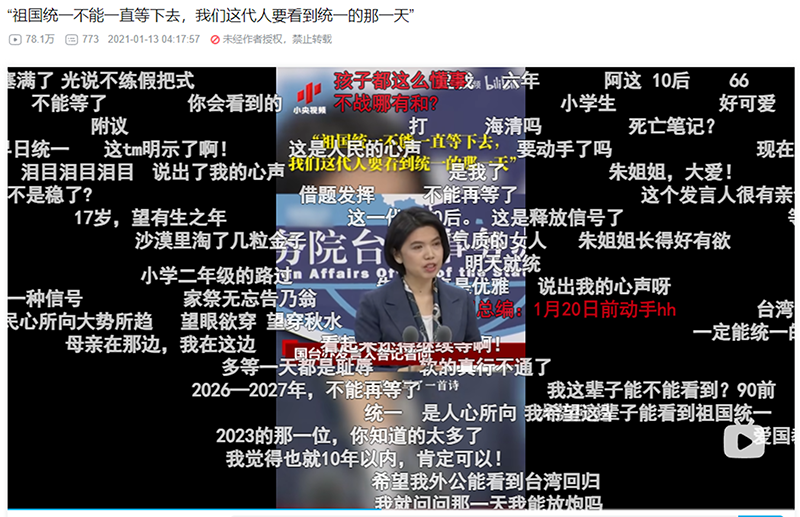
Figure 6: Mainland viewers left comments urging early reunification (13 January 2021).
IV. 2019, Signs on Withdrawing Two Systems Policy.
On 9 October 2019, Ye Qiquan predicted on Dwnews, a website frequently visited by Taiwanese, that “One Country, Two Systems is moving away from Taiwan” [3]. And he forwarded this blog to some of popular political commentators in Taiwan via Facebook. Mr. Ye tried his best to remind Taiwan to take the initiative to pursue “One Country, Two Systems” before it disappears because the “two-system” political solution that is in Taiwan’s interest most.
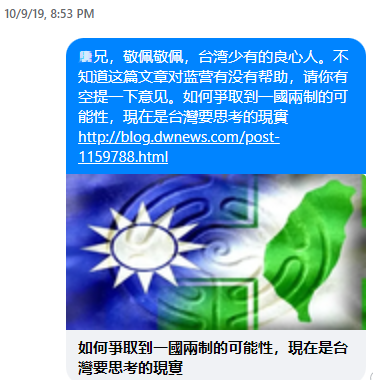
Figure 7: Blogger believed that mainland China is withdrawing its two-system promotion(9 Oct.2019)
V. July 1st, 2021, Official Signal on None of Two-system
In Mainland China’s political operation process, there is a very important routine programme. That is, on every important festival and anniversary, the top national leaders must come forward to make a comprehensive speech. The mainland’s working policies towards Hong Kong, Macau and Taiwan must be spoke and repeated out in every such regular event. In terms of expressions about Taiwan, “One Country, Two Systems” is a phrase that must be mentioned ever in every speech.
On 1 July 2021, Xi Jinping’s spoke at the conference celebrating the 100th anniversary of the founding of the Communist Party of China as a convention. What’s unusual is that he emphasised only the content of “one country” and ignored the “two systems” part [4]. This is the first time since 1997 that the discussion of “two systems” has been deliberately ignored on such an occasion at the highest political level. This is another serious warning that Taiwan is about to lose “One Country, Two Systems” promotion after Ye Qiquan warned so in 2019.
VI. August 10th, 2022, Substance of Two–systems Deprived
On 10 August 2022, the mainland central government officially released a white paper [5] on its Taiwan policy, clearly announcing that “Taiwan has lost the substantial advantages of One Country, Two Systems”.
The relevant discussion is copied below, along with a vernacular translation. Although the vernacular translation is superfluous and unnecessary, it may help some people who are not familiar with the political language of the mainland to understand the mainland’s stance.
6.1. General Description:
(1) Taiwan has no diplomatic rights;
(2) No authority to command troops;
(3) Senior administrative officials must support the central government and be supervised.
(4) Regarding the people’s livelihood structure, the mainland central government has also left a window for negotiation. The central government has clearly stated that the following privileges can be obtained through peaceful negotiations, including no taxation from Taiwan; no major changes in the administrative structure; and no major changes in the economic structure.
(5) The structure of the Taiwan Special Administrative Region is optional, not mandatory.
The following is copied from the fourth and fifth sections of “The Taiwan Question and the Cause of Chinese Reunification in the New Era”.
6.2. Window of Peaceful Talks Reserved
[Content in Second Paragraph of Section IV.]
National reunification by peaceful means is the first choice of the CPC and the Chinese government in resolving the Taiwan question, as it best serves the interests of the Chinese nation as a whole, including our compatriots in Taiwan, and it works best for the long-term stability and development of China. We have worked hard to overcome hardships and obstacles to peaceful reunification over the past decades, showing that we cherish and safeguard the greater good of the nation, the wellbeing of our compatriots in Taiwan, and peace on both sides.
Translation: Chinese central government still maintains a window for peaceful negotiations. It is up to Taiwan to decide whether it is willing to negotiate or not.
vernacular: The ball is in Taiwan’s court. Don’t blame the mainland for not fulfilling its notification obligations.
6.3. One country takes precedence over two systems
[Third Paragraph of Section IV.]
The One Country, Two Systems principle is an important institutional instrument created by the CPC and the Chinese government to enable peaceful reunification. It represents a great achievement of Chinese socialism. Peaceful reunification and One Country, Two Systems are our basic principles for resolving the Taiwan question and the best approach to realizing national reunification. Embodying the Chinese wisdom – we thrive by embracing each other – they take full account of Taiwan’s realities and are conducive to long-term stability in Taiwan after reunification. We maintain that after peaceful reunification, Taiwan may continue its current social system and enjoy a high degree of autonomy in accordance with the law. The two social systems will develop side by side for a long time to come. One Country is the precondition and foundation of Two Systems; Two Systems is subordinate to and derives from One Country; and the two are integrated under the one-China principle. We will continue working with our compatriots in Taiwan to explore a Two Systems solution to the Taiwan question and increase our efforts towards peaceful reunification. In designing the specifics for implementing One Country, Two Systems, we will give full consideration to the realities in Taiwan and the views and proposals from all walks of life on both sides, and fully accommodate the interests and sentiments of our compatriots in Taiwan.
Translation: : One country takes precedence over two systems. All the details about “Two-system” need to be discussed again.
vernacular: The promises made by Ye Jianying and Deng Xiaoping have expired. Negotiations focus on mainland public opinion now.
6.4. Granted Preference to Taiwan Cannot Exceed Hong Kong Has
[Fourth Paragraph of Section IV.]
Ever since the One Country, Two Systems principle was proposed, certain political forces have been misrepresenting and distorting its objectives. The DPP and the authorities under its leadership have done everything possible to target the principle with baseless criticisms, and this has led to misunderstandings about its aims in some quarters of Taiwan. It is a fact that since Hong Kong and Macao returned to the motherland and were reincorporated into national governance, they have embarked on a broad path of shared development together with the mainland, and each complements the others’ strengths. The practice of One Country, Two Systems has been a resounding success. For a time, Hong Kong faced a period of damaging social unrest caused by anti-China agitators both inside and outside the region. Based on a clear understanding of the situation there, the CPC and the Chinese government upheld the One Country, Two Systems principle, made some appropriate improvements, and took a series of measures that addressed both the symptoms and root causes of the unrest. Order was restored and prosperity returned to Hong Kong. This has laid a solid foundation for the law-based governance of Hong Kong and Macao and the long-term continuation of One Country, Two Systems.
Interpretation: The two systems are not static. Modification, improvement and perfection are the essential attributes of Two-system.
(Vernacular: Don’t forget what you did to make trouble in Hong Kong. The rebates given to Taiwan cannot exceed those given to Hong Kong)
6.5. Taiwan SAR Uncertainly. Senior officials supervised.
[Fourth Paragraph of Section V.]
Provided that China’s sovereignty, security and development interests are guaranteed, after reunification Taiwan will enjoy a high degree of autonomy as a special administrative region. Taiwan’s social system and its way of life will be fully respected, and the private property, religious beliefs, and lawful rights and interests of the people in Taiwan will be fully protected. All Taiwan compatriots who support reunification of the country and rejuvenation of the nation will be the masters of the region, contributing to and benefitting from China’s development. With a powerful motherland in support, the people of Taiwan will enjoy greater security and dignity and stand upright and rock-solid in the international community.
(Interpretation: Taiwan Special Administrative Region is an option. Senior officials must support reunification)
(Vernacular: Taiwan’s government officials must support the central government and be supervised)
6.6. No power to command troops
[Sixth Paragraph of Section V.]
The people separated by the Taiwan Straits share the same blood and a common destiny. After reunification, China will have greater international influence and appeal, and a stronger ability to shape international public opinion, and the Chinese people will enjoy greater self-esteem, self-confidence and national pride. In Taiwan and on the mainland the people will share the dignity and triumph of a united China and be proud of being Chinese. We will work together to refine and implement the Two Systems solution to the Taiwan question, to improve the institutional arrangements for implementing the One Country, Two Systems policy, and to ensure lasting peace and stability in Taiwan.
(Interpretation: Now the two sides of the Taiwan Strait are jointly deciding on the two-system plan to ensure that Taiwan will not rebel again)
(Vernacular: Taiwan has no military control, and military power belongs to the central government. The central government must intervene in Taiwan’s government)
6.7. All diplomatic powers are vested in the central government.
[Eighth Paragraph of Section V.]
After reunification, foreign countries can continue to develop economic and cultural relations with Taiwan. With the approval of the central government of China, they may set up consulates or other official and quasi-official institutions in Taiwan, international organizations and agencies may establish offices, relevant international conventions can be applied, and relevant international conferences can be held there.
(Vernacular: Taiwan has no diplomatic powers. All foreign-related powers are vested in the central government.)
VII. Future, no peace talks initiated from Taiwan.
7.1. Taiwan has erected a strong barrier against reunification.
7.1.1 Strong Anti-mainland Atmosphere
In the process to pursue Taiwan’s independence, the barriers against “One Country, Two Systems” have been gradually raised and thickened. From 1992 to 2023, the proportion of people who identify as both Taiwanese and Chinese has continued to decline, falling from 46.4% to 30.5%. Over the same period, the proportion of people who identified only as Chinese declined steadily from 25.5% to 2.5%. And the proportion of self-identified Taiwanese rose steadily from 17.6% to 62.8%.
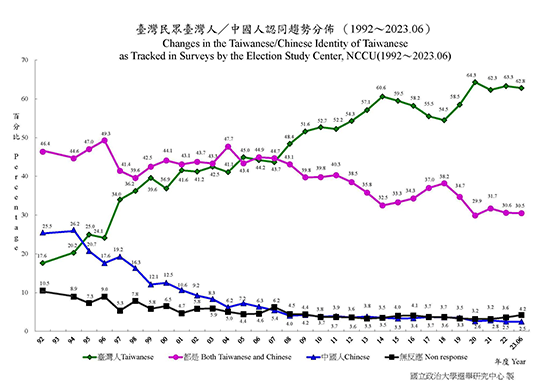
Figure 8: Taiwanese self-identification
7.1.2. Manipulated Anti-mainland environment
In a wide range of English-language databases and even various Chinese databases outsides mainland China, majority of historical data is added with the perspective and background of the political stance supporting Taiwan’s independence. When accusing China’s missile test in 1996, Lee Teng-hui’s visit to the United States during his “presidential term” was deliberately defused.
When all Western public opinion strongly criticised China’s anti-secession law, they forgot that Lee Teng-hui had ended the operation of the Taiwan Provincial Government on the island of Taiwan. Lee Teng-hui’s “two-nation theory” caused conflicts across the Taiwan Strait that was ignored by the West. The whole Western world has forgotten that Chen Shui-bian was the driving force behind the anti-secession law. Chen Shui-bian once said that the two sides of the Taiwan Strait are one country on each side. He also threatened to hold a referendum on the island of Taiwan to choose between independence and reunification.
Events that have nothing to do with the mainland can also be used to hate the mainland. For example, the 228 Incident in 1947 was actually a conflict between the regime ruling Taiwan and the local people. Even more than 70 years later, it can be extended to mean that mainlanders are oppressing Taiwanese.
All real and untrue examples within the island of Taiwan, in the English database and in the Overseas Chinese database have been placed in a linguistic context that supports Taiwanese independence.
7.1.3 Political situation unfavourable to mainland China.
Some international political events have been interpreted unilaterally by the local people, thus fostering an independent atmosphere in Taiwan. For example, the successful independence of East Timor, the semi-independence of Kosovo, the successful intervention of the United States in Syria, the continuous expansion of Israeli settlements, etc.; these examples have been extended to mean that the United States can dominate major political trends in the world and then to support Taiwan’s independence.
The trend of US suppression of China did not start with Donald Trump. From Bill Clinton to George W. Bush to Donald Trump, it is actually a continuous process. The implementation of the Wassenaar Arrangement; the seizure of the Galaxy freighter on the high seas; the bombing of the Chinese embassy in Yugoslavia; Europe reviving the concept of sweatshops and blocking Chinese products; the deification and elevation of the political status of the Dalai Lama, deliberately ignoring that he is a real slave-owner in modern times; provoking the nationalisation of the Diaoyu Islands incident in Japan; deployed the THAAD anti-missile system in South Korea; promoted the South China Sea international arbitration case; fabricated the Xinjiang concentration camp incident; fabricated the Xinjiang cotton incident; participated in the anti-extradition riots in Hong Kong in 2019; created the theory that “China should be responsible for the spread of COVID-19”; blocked Chinese companies such as Huawei and DJI. In this series of political conflicts, China has always been the passive party.
All these events have been deliberately classified as favourable political factors in support of Taiwan’s independence. It is foreseeable that if there is no strong steps to stop this trend, the power of the US group to block and suppress China will automatically and continuously increase.
7.2. Irrational Judgements on International Politics
7.2.1 Unable to assess China’s power in the international system.
Taiwan has lost the ability to understand China’s current strength in the international system.
Even in 2019, Taiwan’s main judgement is still that the United States is the reliable power that Taiwan can rely on. Taiwan has the following shortcomings in its understanding of international politics.
Failure to recognise that the political power relies on economic capability.
Taiwan generally has a superficial understanding of the determinism of military power. It believes that military power is the essence of political power.
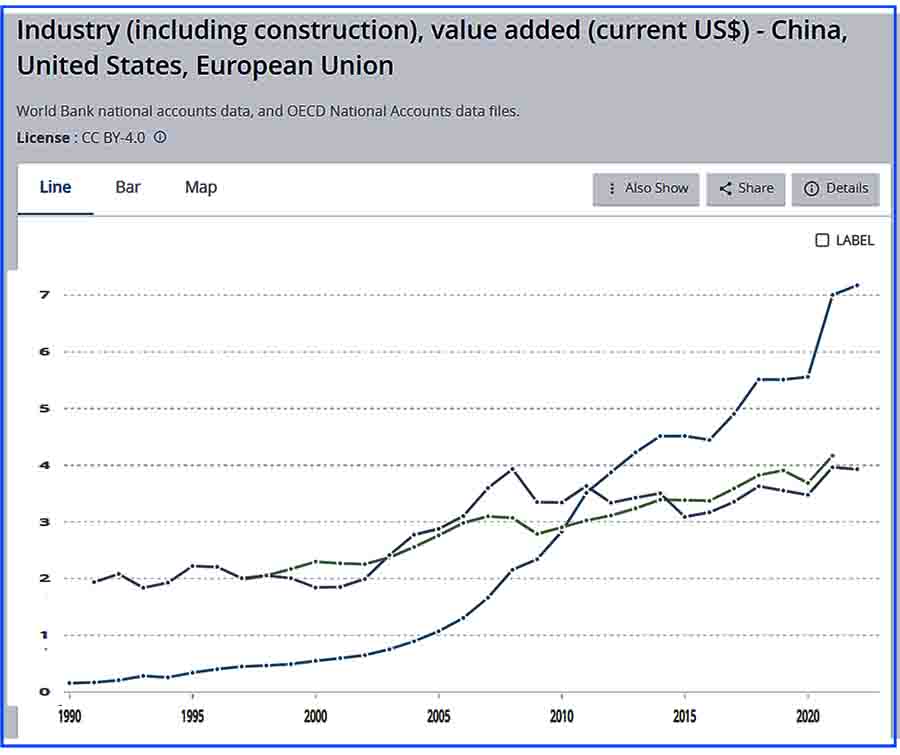
According to the World Bank, since 2016, China’s GDP income in terms of purchasing power has officially surpassed that of the United States. The part of GDP power that can really be converted into military power is mainly industrial production capacity and agricultural output. China’s production capacity in these two areas already exceeds or close to that of the United States and the European Union combined.
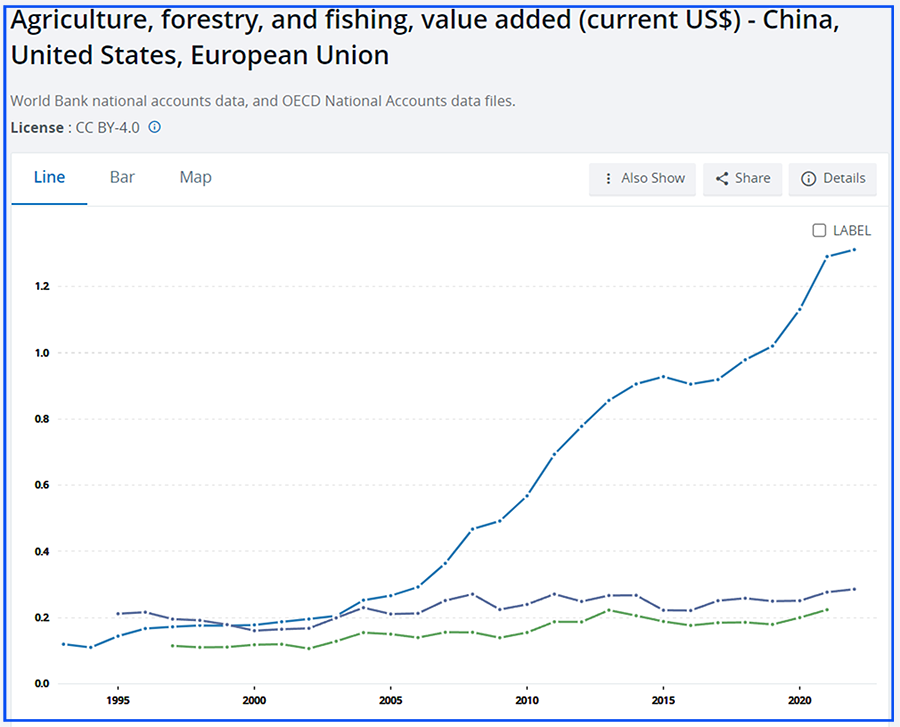
Taiwan does not understand the actual ratio of China’s military investment output value to the US military output value.
Although there is currently no data on the military cost difference between China and the United States, there is currently a rough military cost conversion ratio between China and the United States. The cost for China to produce aircraft carriers at the similar level is 1/6 that of the United States. The cost for China to produce cruisers at the similar level is 1/6 that of the United States. China’s cost to deploy warships is 1/6 that of the US. China’s cost of military personnel is 1/5 that of the United States. The real value of China’s military expenditure is essentially the same as that of the United States under the PPP index. US military power must be deployed around the world for global defence. In comparison, China’s military power only needs to defend a local area.
There is no understanding of China’s real advantages over the United States.
According to Ye Qiquan’s Nation (Group) War Strength computing model [6], in a hypothetical conflict in 2026, the US group will not be able to form superior war forces around Taiwan. If this hypothetical conflict becomes a reality, it may open a new historical window for land-based power to suppress sea-based power.
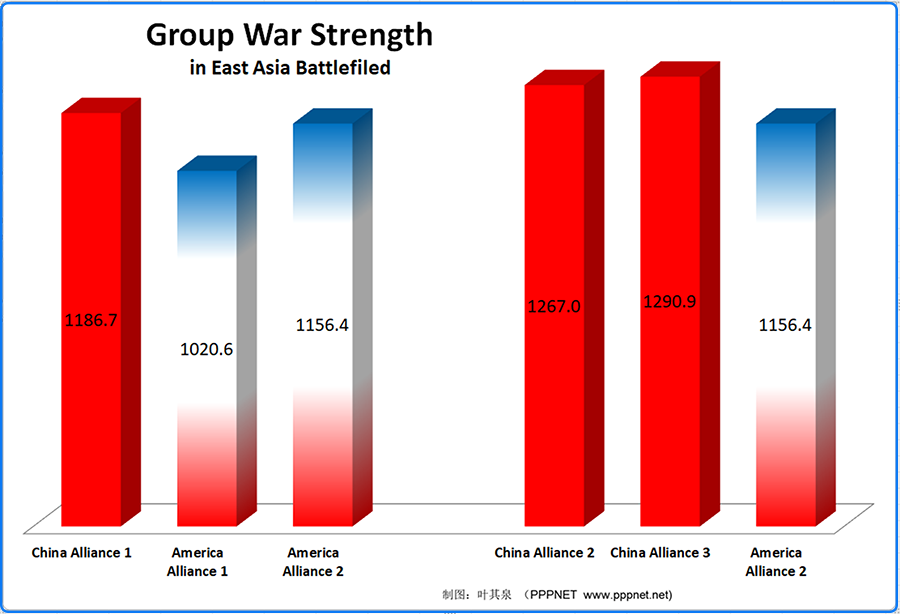
Figure 11: Group War Strength in Ease Aisan
7.2.2 Lack of mature political judgement
Taiwan does not understand the present inability of the United States to maintain the present world order.
According to Ye Qiquan’s predictions in April, May and June 2022, the power of the US alliance (Ukrainian alliance) will not be able to maintain a sufficient advantage in central Ukraine. The Russian-Ukrainian war will be entangled in Central Ukraine for a long time. Russia will establish about seven local governments in Ukraine. The Russian-Ukrainian war will not end before 2026 [7, 8, 9]. These predictions have been largely confirmed by the current dynamics on the battlefield. However, the majority of public opinion in Taiwan still overwhelmingly believes that the United States is the absolute power that dominates world politics.
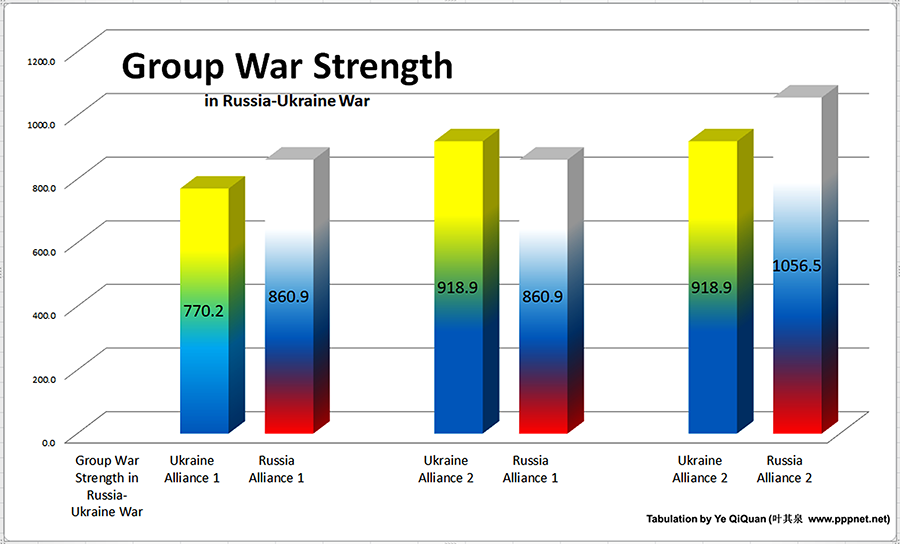
Figure 12: The United States cannot meet the Russian challenge in Europe alone.
Taiwan does not understand that total war and group war have indeed returned to the world political stage.
In fact, whether it is the conflict initiated by Russia, the rise of the Arab world, or the challenge initiated by China in 2026, the United States is incapable of facing these challenges independently. Even if group tactics are used, according to Ye Qiquan’s computing model on Nation (Group) War Strength, the U.S. group will also be unable to form a power superiority over China in the Taiwan Strait turmoil in 2026 [6].
Taiwan fails to understand the importance of mainland public opinion on Taiwan’s security
The Taiwanese have always rejected the political benefits of China’s “One Country, Two Systems” policy. They stubbornly and wrongly believe that the mainland wants to impose “One Country, Two Systems” on them. Based on this misconception, the Taiwanese mistakenly believe that if they reject the mainland’s political offer, they will not risk losing their political advantage. But the fact is that once the mainland people believe that the Taiwanese have betrayed the overall national or nation interests, the basis for Taiwan’s political advantage will collapse. Because of the mainland people’s disgust and resentment at Taiwan’s manipulation of Taiwan’s independence, Ye Qiquan noticed in 2019 that the mainland central government was withdrawing the “One Country, Two Systems” policy. Although Ye Qiquan had tried hard to warn Taiwan, Taiwan had no response to this change in trend and Ye Qiquan’s warning. That conducts Taiwan in a missed three-year historic opportunity. Taiwan finally officially lost the de facto “One Country, Two Systems” on 10 August 2022. This outcome was essentially the result of the changing public opinion of the mainland people towards Taiwan.
Taiwan does not understand the political language of mainland China.
In 2019, Ye Qiquan predicted that Taiwan would lose the political benefits of “One Country, Two Systems”[3]. His capacity on prediction is based on his reading and understanding Chinese political language. This prediction came true three years later. However, Taiwan has never understood the mainland’s political statements. Even Taiwan did nothing in the face of Ye Qiquan’s warning.
It has been a year since mainland China issued its white paper on its policy towards Taiwan on 10 August 2022. So far, no one in Taiwan, whether scholars or officials, has come forward to interpret the content of this policy announcement. From the above examples, it can be concluded that Taiwan has completely lost its ability to understand mainland China’s political actions. But this kind of political incompetence is an absolutely fatal flaw for weak Taiwan.
7.3 Taiwan cannot change its current political stance.
(1) Full independence is Taiwan’s target.
Mainstream public opinion in Taiwan favours full independence. Its minimum goal was at least a confederal state structure like the Czechoslovak and Austro-Hungarian empires.
(2) Taiwan missed and lost the best commitments
Taiwan failed to catch the political commitments of Ye Jianying and Deng Xiaoping. Ye Jianying and Deng Xiaoping took the initiative to release substantial political benefits to Taiwan. These benefits include the following main points. Taiwan has high-level diplomatic power; Taiwan has an independent military and a fully independent military command; Taiwan has full administrative power; Taiwan has full economic autonomy; Taiwan has final judicial power; the mainland does not send military and political personnel to administer Taiwan; Taiwan’s top officials hold specific and exclusive chairs in the state’s power structure. These political conditions are much higher than that hold by states in the United States, but Taiwan ultimately rejected this historic opportunity.
- No longer political favors from Mainland
Taiwan’s deep involvement in the anti-extradition riots in Hong Kong in 2019 was seen by the mainland people as a betrayal of the country and national interests. Calling for armed reunification on Taiwan, that began in 2016, and reached a peak in 2019. This kind of public opinion has put tremendous pressure on the mainland government for military reunification. This is also the fundamental reason why the central government of mainland China officially took away Taiwan’s substantial political interests of “One Country, Two Systems” on 10 August 2022.
It is very clear that the mainland is continuously reducing the political benefits toward Taiwan. Any Taiwanese politician will risk himself / herself, if he/ she try to negotiate with the mainland. It is impossible for the people in Taiwan to accept the political restrictions currently imposed by mainland China [3].
(4) No chance to elect a tough politician
Taiwan has no chance to elect some tough figures like Thaksin, Modi, Erdogan and Trump who can partially or completely change the political atmosphere. The basis for the emergence of the above political strongmen is the existence of serious antagonistic elements in the country, including class antagonism, political antagonism and religious antagonism, etc. These antagonistic factors are the basis for the emergence of political strongmen under the model of electoral politics. But Taiwan has now a de facto flat political structure. The political aspect objectively friendly to the mainland has almost no statistical significance in Taiwan. Taiwan currently has no serious economic disparities, no serious religious antagonisms, and no serious racial differences. In other words, Taiwan does not currently have the political space and material basis to produce powerful politicians. In the future, it is unlikely that an opportunity will suddenly arise in Taiwan to produce a powerful figure who can reverse the political correctness. Frankly speaking, there will be no chance for Taiwan to engage in peaceful negotiations with the mainland in the coming period.
VIII. Future, no proactive peaceful talks from Mainland
- After at least 15 years of systematic preparation, China will be convinced that war will bring huge national interests. On the contrary, if a peaceful approach is chosen, China’s national interests will be greatly diminished.
- According to Ye Qiquan’s Nation(Group) War Strength computing model, the US group will have no superiority in war capabilities during the Taiwan Strait turmoil in 2026[6]:
- China will use a conflict to show that the superiority of land-basedpower is returning (or has returned) to the stage of military China is trying to force the naval-based power out of the central stage of political system gradually through some low level conflicts. That would allow China to gain political profit at minimal cost.
- Peaceful reunificationwill severely limit China’s geopolitical gains.
- Peaceful reunificationwill seriously consume China’s governance costs (political costs, economic costs and historical costs).
- Peaceful reunificationwill seriously slow China’s historical progress.
8.1. USA faces major shortcomings In Sino–U.S. conflict scenario
In the hypothetical scenario of turmoil in the Taiwan Strait and conflict between China and the United States in 2026, the United States will face at least the following major shortcomings:
8.1.1 US troops cannot land China
China has the inherent advantage of being able to choose the right moment to initiate action in creating unrest in the Taiwan Strait. Once mainland China completes its occupation of the entire island of Taiwan within 4-11 days, the entire Western bloc will lose the opportunity to confront the Chinese army. There is no chance for them to land on Chinese soil (including the island of Taiwan). This military fact essentially deprived the American bloc of the possibility of winning the war.
8.1.2 The higher cost of combat-level weapon in USA
The input-output efficiency of a land-based airport plus short-range missiles is much higher than that of a mobile airport plus short-range missiles.
Before discussing the costs of war, we can make some assumptions. (1) Assume that the difficulty to destroy American mobile airports is the same as the difficulty to destroy Chinese land-based airports; (2) Assume that the range and bomb load of the US F35 are the same as those of China’s J20 ; (3) Assume that the range of US air-launched missiles is the same as the range of Chinese air-launched missiles.
Among the above three assumed military costs, even if the costs of the United States and China are the same, China can defeat the United States through economic consumption in a long conflict through cheaper land airports and cheaper missile costs. And in fact, the United States is a relatively weak party under the three assumptions above [10]. In other words, the cost of US on combat-level weapon is higher.
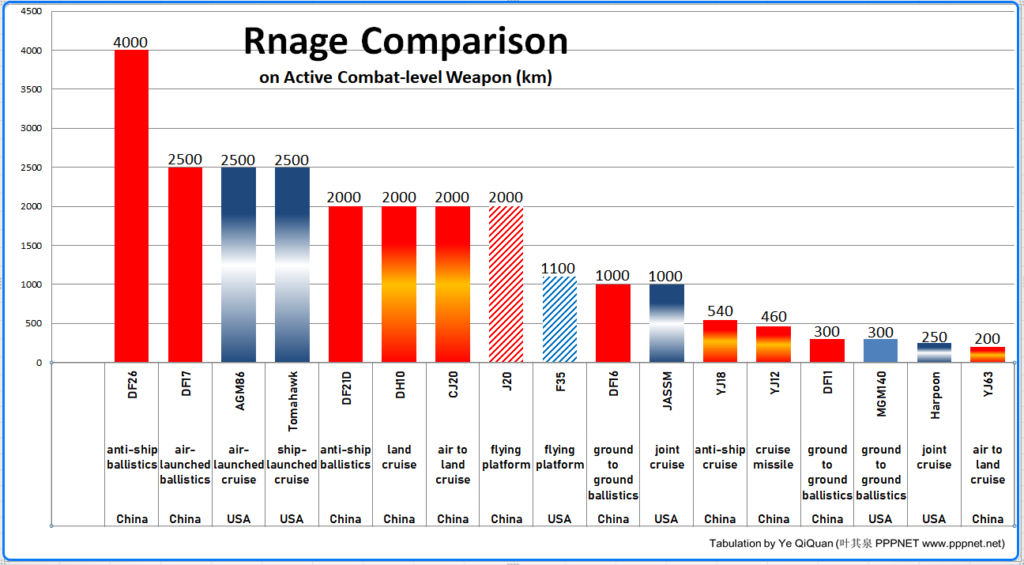
Figure 13: Range Comparison of Combat-level Weapon
8.1.3 The higher cost of strategic weapons in USA
If U.S. aircraft carriers and Chinese medium-range missiles are assumed to be strategic weapons that will enter the battlefield at the same time, their usage costs can be compared.
The cost of arms includes many units of account. These include manufacturing costs, storage costs, maintenance costs, transport and flow costs, personnel training costs, decommissioning and dismantling costs, post-disassembly processing costs, etc. It is difficult to track the actual costs of each cost unit. Manufacturing costs (or original purchase costs) are among the most readily available.
cost of the US aircraft carrier fleet
According to information published in 2021, the cost of the US aircraft carrier battle group can be roughly listed as follows.
|
Table2: U.S. aircraft carrier battle group (manufacturing cost) (millions of dollars) (2021 data) |
|||
|
Ship Type [13] |
Quantity [13] |
Original manufacturing unit price (M $) |
Original cost (M $) |
|
Aircraft carrier(CVN-78) |
1 |
12471.0 [15](2021) |
12471.0 |
|
Cruiser(CG) |
1-2 |
1000 [14] (2021) |
2000 |
|
Destroyer (DDG51) |
2-3 |
739.2 [16](2021) |
2217.6 |
|
Frigate (FFG62) |
2-3 |
943.73 [17](2021) |
2831.2 |
|
Submarine (SSN774) |
1 |
1807.4 [18] (2021) |
1807.4 |
|
Auxiliary (TAO 205) |
1 |
591.6 [19] (2021) |
591.6 |
|
Air superiority fighter (F-35) |
20-28* |
94.4 [14] (2021) |
2360 |
|
Strike fighter (F/A-18) |
30-36 |
29 [14] (2021) |
1044 |
|
Surveillance(E-2C/D) |
4 |
80 [14] (2021) |
320 |
|
Electronic Warfare(ES, EA,E-2D) |
14 |
80 [14] (2021) |
1120 |
|
Rotorcraft (UH-60M) |
6 |
15.8 [20] (2021) |
94.6 |
|
Cargo (C-2A) |
2 |
38.96 [14] (2021) |
77.92 |
|
Total manufacturing cost |
26,935.3 |
||
|
Tabulation: Ye Qiquan ( 叶其泉PPPNet www.pppnet.net) |
|||
The cost of China’s intermediate-range missiles
The original acquisition cost (PAUC) or average acquisition cost (APUC) of US weapons is easy to find out. The exact cost of China’s intermediate-range missiles is unclear. It is difficult to understand the characteristics and prices of Chinese military products.
Some US lawmakers once believed that the cost of China’s 1,238 anti-ship missiles was equivalent to the cost of an aircraft carrier. Some US military commentators believe that the cost of China’s DF21D is in the millions of dollars.
Compared to Western estimates of the lower cost on China’s ballistic missiles, Chinese online public opinion has a higher estimate of the cost on that. Chinese online public opinion estimates the cost of a Dongfeng 21D to be between US$10 million and US$24 million. The production cost of the Dongfeng 26 is between US$15 million and US$30 million. Today, we tentatively set the prices of the Dongfeng 21D and Dongfeng 26 at US$24 million and US$30 million, respectively, and compare exchange rates.
Exchangable Ratio
|
Table3: Cost comparison between Chinese anti-ship weapons and the US aircraft carrier fleet |
|||
|
Item |
Unit Price (M $) |
Exchange Value (M $) |
Equivalent No.(pcs) |
|
Dongfeng 21D |
24 |
26935.3 |
1122 |
|
Dongfeng 26 |
30 |
26935.3 |
898 |
|
Tabulation: by Ye QiQuan( 叶其泉 from PPPNet www.pppnet.net) |
|||
According to current cost estimates on the Internet, the cost of about 400-600 Chinese intermediate-range missiles may be equivalent to the cost of a US Ford-class aircraft carrier; 900-1100 missiles are roughly equivalent to the cost of a US aircraft carrier battle group. Even if this estimate is reduced by half, if 200 Chinese intermediate-range missiles are equivalent to the cost of an American aircraft carrier and 450 missiles are equivalent to the cost of a carrier battle group, it should be credible that these quantities can offset the combat effectiveness of an American aircraft carrier. This shows that the United States also has a cost disadvantage in the use of strategic weapons.
Tables 2 and 3 show that the economics of China’s strategic weapons are far better than those of the United States. At the same time, this is also a “hypothetical fact” shared by China and the Western online world.
Due to the cost and scale advantages of China’s manufacturing industry, Chinese-made intermediate-range missiles have become weapons that can be deployed on the battlefield on a large scale in terms of economic cost.
At the same time, there is online speculation that China has some 3,000 intermediate-range missiles in stock. What is certain is that once the Sino-US conflict becomes a reality, China’s production of medium-range missiles will definitely be faster than the United States’ production of aircraft carriers.
8.1.4 Extremely difficult political process
Regardless of whether it is based on the impossibility of the United States landing on Chinese land or referring to Ye Qiquan’s Group War Strength computing model, one basic point is tacitly accepted: China will not fail militarily [6, 10].
But from the perspective of maintaining the current basic world order, the United States cannot afford military defeat. This is another essential basis for the conflict between China and the United States.
It will be very hard to guarantee that both the USA and China will not suffer from military defeat. To successfully move between these two bases, politicians in both countries face a difficult political decision-making process.
8.2 China has better weapons effective range
Calculating [11] on the basis of the three indicators of “weapon effective range” formulated by Ye Qiquan, China’s anti-ship weapons have comprehensive advantages over American ship-launched weapons.
8.2.1 Range (Killing Distance)
According to the standard conception of current Internet information, the range of Chinese-made intermediate-range missiles has exceeded the combat radius of the F35 taking off from a US aircraft carrier, plus the range of air-launched cruise missiles. This is the first time in almost 400 years that the range of land-based weapons has exceeded that of sea-based weapons.
|
Range Comparison (Chinese anti-ship missile VS US ship-launched missile) (km) |
||||
|
Group |
Weapon Class |
Missile |
Range |
Total Range (Missile + Platform) |
|
China |
anti-ship ballistic |
DF26 |
4000 |
4000 |
|
China |
Air-Launched Ballistic |
DF17 |
2500 |
4000 |
|
USA |
air-launched cruise |
AGM86 |
2500 |
3600 |
|
USA |
ship-launched cruise |
Tomahawk |
2500 |
2500 |
|
USA |
air-to-ground cruise |
JASSM |
1000 |
2100 |
|
China |
air-to-ship cruise |
YJ18 |
540 |
2040 |
|
China |
anti-ship ballistic |
DF21D |
2000 |
2000 |
|
China |
flying platform |
J20 |
|
2000 (Valued as 1500) |
|
China |
air-to-ship cruise |
YJ12 |
460 |
1960 |
|
China |
air-launched cruise |
YJ63 |
200 |
1700 |
|
China |
flying platform |
J15 |
|
1500 |
|
USA |
cruise |
Harpoon |
250 |
1350 |
|
USA |
flying platform |
F/A18 |
|
1100 |
|
USA |
flying platform |
F35 |
|
1100 |
|
Tabulation: Ye QiQuan (叶其泉 from PPPNet www.pppnet.net) |
||||
Table 4: Comparison of ranges of anti-ship and ship-launched weapons
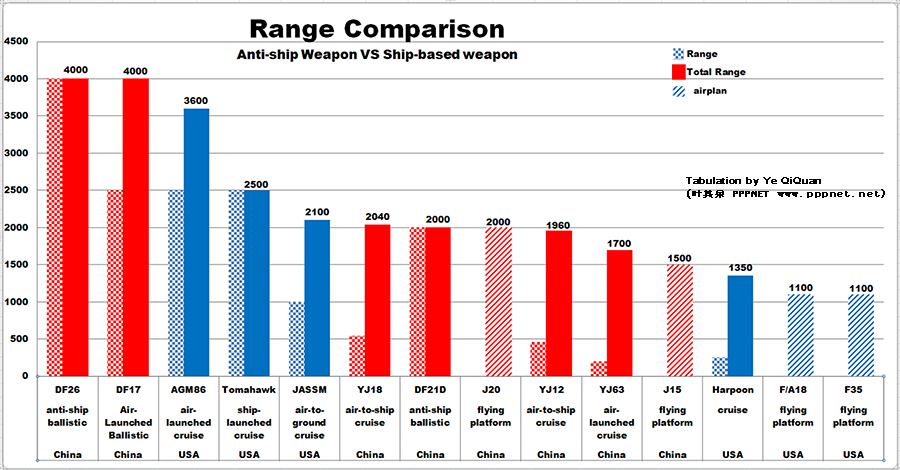
Figure 14: Comparison of Ranges (anti-ship weapons VS ship-based weapons)
8.22 Issue about Lethality (Damage Effect)
In the previous section, the range of weapons at the combat and strategic levels was compared between China and the United States. China also seems to have an advantage in the economy and in the large-scale use of weapons.
The damage effect of American cruise missiles is certain. This fact has been demonstrated in many actual wars. The damage effect of Chinese missiles is still subject to speculation.
There are unconfirmed online rumors. It is said that China once launched a medium-range anti-ship missile under the monitoring environment of the United States and successfully hit a moving target. But there is no clear proof of this rumor.
Among the three important indicators that constitute the effective range of weapons, Chinese weapons have clearly taken the lead in killing distance and economic performance. Verifying its damage effect will surely become a temptation for China to put its weapon into actual combat. It is foreseeable that China may deploy its anti-ship weapons into other low-level conflicts. It will benefit China to verify the damage effect of anti-ship weapons through intervening in low-level conflicts in other regions. This practice will also be helpful to improve China’s war theory and war methodology.
8.2.3 Significance on Land-based Weapon taking power superiority
Temptation
China’s progress in the field of weapons and equipment will create a temptation for China. That is, to intervene more actively in military conflicts in other regions. This is a drastic change in China’s foreign policy. For the past 40 years, China’s strategy has been to “hide its strength and bide its time”.
The basic starting point for China to intervene in conflicts in other regions is to verify the performance of China’s anti-ship weapons. At the same time, China’s research into the methodology of warfare is also being tested. This is all in preparation for defeating the United States in the East Asia War in 2026.
Significance
The effective range of China’s anti-ship missiles may have exceeded the range of US carrier-based aircraft plus cruise missiles. This is still a hypothesis, as the rumour has not been confirmed. If this hypothesis is true, it will have important implications on three major political levels.
1) Restarting the historical process of land-based weapons replacing sea-based weapons as superior weapons on the battlefield [10]. For the past 400 years, sea-based weapons have had the advantage of effective range.
2) The importance of the aircraft carrier fleet will inevitably gradually decline, eventually becoming the country’s secondary armed force.
3) Political forces parasitic on the advantages of sea-based weapons will enter a downward path.
8.3. Peaceful unification will severely limit China’s geopolitical gains
8.3.1 Peaceful unification Limit China’s Geopolitical Potential in Northern Sea of Japan
There is an important geopolitical background at present, which is the political struggle between the American alliance (the Ukrainian alliance) and the Russian alliance. This struggle provides an opportunity or possibility for China and Russia to start political cooperation in Northern Sea of Japan region. It is even possible that China will use the Southern Kurils to launch an attempt at trilateral cooperation within China, Japan and Russia. However, if Japan is not involved in the war, this cooperation would face many political obstacles. Therefore, involving Japan in military conflicts is beneficial to China’s long-term geopolitical interests.
8.3.2 Peaceful unification will limit China’s ability to exploit Taiwan’s geographical advantages
(1) Label of “Taiwanese” harms China’s power
Peaceful unification cannot remove the political connotation of the political label “Taiwanese”. This political connotation has a serious weakening effect on China’s overall political power[3].
- Taiwan SAR limits China’s geopolitical interests.
Peaceful unification severely limit the Chinese central government’s ability to exploit the geographical advantages of Taiwan island. If the Chinese central government cannot effectively build the “land bridge” or “land sword” function over the island of Taiwan, China will miss its strategic interests. China will not suppress (weaken) the sea-based political power over Japan and South Korea, also. Taiwan risks the next escape from China to a stronger maritime power alliance in a historical perspective.
(3) Taiwan is the base for expanding geopolitical interests in the northern Sea of Japan
If the Chinese central government does not effectively exploit the geographical advantages of the island of Taiwan, the opportunities for geopolitical cooperation in the Northern Sea of Japan will be useless. This is an investment in political power that will not bring obvious benefits, or it is a waste of political power.
8.4. Peaceful unification costs China
Peaceful unification will seriously consume China’s governance costs (political, economic and historical costs);
The content of this part is entirely consistent with the concept previously proposed by Ye Qiquan. No new or additional content. See Ye Qiquan’s article [3]. (https://en.pppnet.net/chinas-unifying-plan9-lost-intersection-of-two-system/ )
8.5. Peaceful unification slows down China
Peaceful actions will seriously slow down China’s historic progress.
8.5.1 Peaceful unification will lose or delay the possibility of establishing an East Asian Cooperation Zone.
(1) In the 1990s and 2000s, there were attempts to establish an East Asian cooperation zone. But history has shown that it is impossible to establish a full-fledged East Asian cooperation area peacefully and gradually. Such attempts at peace may even have negative political and economic consequences;
(2) The non-peaceful approach to building an East Asian cooperation zone must be based on the following factors: the compression of the sea-based political power over Japan and South Korea; the retreat of US power in East Asia [12];
(3) An antecedent factor favors the goal on compression of the sea-based power over Japan and South Korea. What is to set up a “fixed and solid anchor point to extend land-based power” on the island of Taiwan and in the northern Sea of Japan;
(4) The most reliable way to establish a fixed anchor of land power on the island of Taiwan is on military means, not by peaceful means;
(5) Peaceful means will not be helpful in establishing a Sino-Japanese-Russian cooperation base in the northern Sea of Japan or even the southern Kuril Islands. Peaceful means will miss the historic opportunity as the European power structure is risky in reorganisation.
(6) Peaceful unification cannot initiate a historic process of US power withdrawal from East Asia.
8.5.2 Peaceful unification Will Increase China’s Historical Difficulties
(1) From a historical point of view, postponing the establishment of the EACZ is tantamount to a high political cost for China.
(2) From a historical point of view, China has greater historical problems or tasks than the establishment of the EACZ.
(3) Postponing the establishment of the EACZ is tantamount to allowing China’s biggest historical problem to be stabilised, repaired and strengthened.
IX. 2026, the opportunity and the two driving forces for reunification
2026 is the best time for the Chinese central government to begin the process of reunifying Taiwan. This timing has a double intersection of international factors and domestic factors.
In terms of international factors, many forces are ready to oppose the existing international order. These powers are ready to intervene at any time in a complex chaos to fight for their own national interests.
In terms of domestic factors, China has many overlapping factors that promote unification.
If China’s unifying action in 2026 leads to a formal military conflict between China and the United States, it will easily trigger a global turmoil. This turmoil can easily spread in many directions, especially to the core areas of Europe, the Middle East, Central Asia, North Africa and Central Africa. The chaos in East Asia actually is not the fundamental source resulting in global turmoil, but a set of countries waiting for an opportunity for their own national interests, they are.
9.1 The United States cannot quell chaos in Europe.
1) The European war that breaks out in 2022 will cause political turmoil. In particular, it will restart the historical process of continual shifting of borders between European countries.
2) The United States was unable (unwilling) to suppress (ceasefire) the European war. War and chaos became options for American initiative.
3) Maintaining world order through sea-base power is a costly. If the United States loses the ability to “tax” and “collect tax” peacefully, it will have to resort to war and chaos to keep or enlarge the “power gap”. This “power gap” is necessary to maintain a power order. It is also a force that ensures the “tax sources” not escape.
4) Quickly quelling the chaos in Europe is not in US strategic interests. Simultaneously weakening the EU and Russia is the preferred way for the United States to maintain (and increase) the “power gap”. It is also a selected way for the United States to maintain its global dominance.
5) Russia and the United States together are the dominant forces on the battlefield in Ukraine. The United States alone cannot determine the direction of the war until Russia achieves ideal gains [9].

9.2 Lots of Countries are ready to join the process of deconstructing European power.
2026 will undoubtedly be a more turbulent year for international politics. At present, war has indeed become a common necessity for many countries or political groups. In diplomatic parlance, this situation can be described as “many countries are politically and ideologically willing to engage in turmoil that advances their own national interests”.
There may have been many different reasons and points that led to the outbreak of the Russian-Ukrainian war in 2022. The real impact of the Russian-Ukrainian war (really a 2022 European war) is already clear now. In other words, the historical script of constant fluctuations in European borders has been restarted, or at least is in the process of being restarted. The process of reorganising power in Europe has begun, or at least is preparing to begin. At the same time, lots of countries are politically and psychologically ready. They are ready to seize the historic opportunity to join this process in order to expand their respective national interests.
These countries include not only core European countries, but also peripheral European countries, North African countries, Arab countries and other continental countries.
9.3 Russia has set its sights on the L1 line.
Since 2014, non-governmental organisations and self-media in Europe and USA have widely and deeply hyped the concept that “the largest European country is Ukraine”. In fact, a cultural and philosophical war is breaking out to define the “non-European identity” of Russians. This cultural and philosophical war, which has driven Russians out of Europe, has created a general crisis of philosophy and faith among Russians.
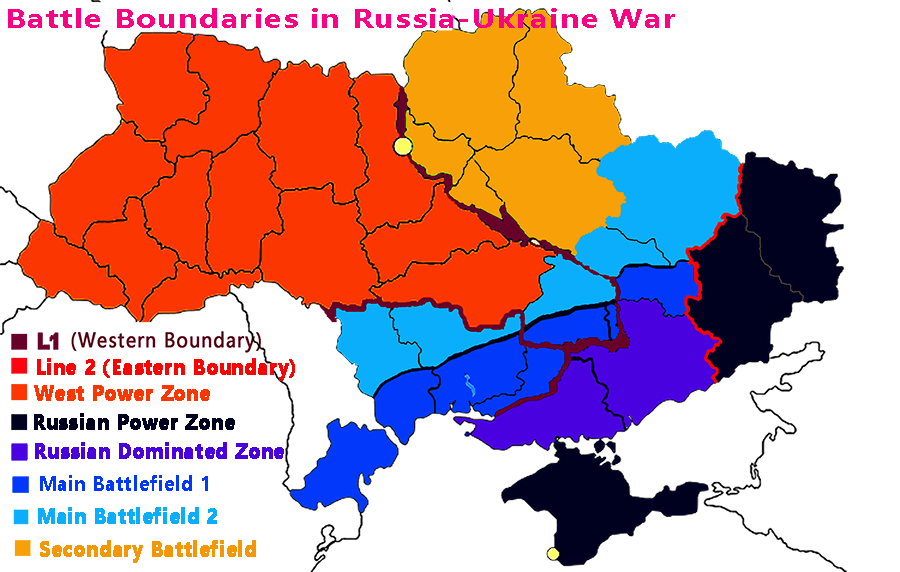
Figure 16: Russia is likely to extend its security borders to the L1 line within 100 years.
This culture war, which has erupted since 2014, directly threatens the philosophical and cultural foundations of the Russian nation. Under great threat, Russians have identified the L1 line as a new frontier that can protect their national identity[6,7].
If Russia sees the potential for large-scale, high-intensity instability in Europe or elsewhere, it will have no incentive to suppress the war in which it is currently engaged.
9.4 New needs will actively seek leaders and windows
If the world economy enters a prolonged period of stagnation, there will be a need to establish a new distribution plan or a new price order.
If there is no rapid revolutionary technological progress and the growth and expansion of the world economy cannot be quickly restored, there will naturally be calls for a redistribution of wealth.
At present, there seems to be no sign of a disruptive technological revolution in the United States, China, Europe or elsewhere. The possibility of rapidly boosting global economic aggregate growth is quite remote. In most countries below the average income line, calls for wealth redistribution will gradually increase. The world power leadership will face comprehensive, multi-point and multi-dimensional resistance. Total political chaos is a reasonable expectation.
If there is no major economic revolution to reverse the decline of the world economy, and if the demand for wealth redistribution cannot be effectively responded to and dealt with, the voice for a new world order through political revolution or philosophical revolution will naturally occur.
All these needs, including wealth redistribution, political revolution or philosophical revolution, will automatically look for windows or leaders to embody their needs. These needs will have a negative impact on the existing power order.
9.5 The rise of land power requires a window to show off
Of the three characteristics that make up the Weapon Effective Range, land-based medium-range missiles have shown advantages in the two items “Range” and “Economy” [10]. Another important characteristic, “Lethality”, has not yet been verified. From a historical perspective, a new type of weapon will certainly seize an opportunity to verify its capabilities. That is, long-range land-based weapons need a window to verify their third important attribute.
This requirement would become an important factor in promoting war. It will be a big temptation. Political efforts may delay this window of opportunity, but they are unlikely to prevent it.
9.6 China’s practical needs
9.6.1 Consoling China’s historical pain
The historical experience of unfair treatment has aroused the discontent of Chinese public opinion.
Looking back at the history of colonial wars since the First Opium War in 1842, China has always been the target of exploitation by those top powerful powers. Even though China gained the status of a victorious country in the First and Second World Wars, the world power order did not give China a truly fair and equal opportunity for development. This is the historical basis of the Chinese people’s dissatisfaction with the existing world power order.
9.6.2 Appease Chinese Public Anger
In order to attack China, the Dalai Lama was awarded the Nobel Peace Prize in 1989, deliberately ignoring the cruel historical fact that he was a real slave-owner who still exists in modern times. In 1993, the United States carried out forced searches of Chinese merchant ships on the high seas. In 1998, certain countries surrounding China were allowed to break nuclear restrictions. In 1999, the US launched five missiles at the Chinese embassy in Yugoslavia. In 2012, Japan was forced to nationalise the Diaoyu Islands. In 2016, the US deployed the THAAD anti-missile system in South Korea. In 2016, the South China Sea arbitration case was launched. In 2019, the Xinjiang concentration camp incident was fabricated. The Xinjiang cotton incident was fabricated in 2010. In 2019, the US and the UK were deeply involved in the Hong Kong anti-extradition riots. The above series of humiliating events has greatly stimulated the Chinese people’s resistance to the American imperial order.
In 2019, Taiwan’s administrative government and ordinary residents were extensively, actively and deeply involved in Hong Kong’s anti-extradition turmoil, which also inspired Chinese mainlanders to resist the existing imperial order. Chinese mainlanders focused their anger on the rapid armed reunification of Taiwan. This strong public opinion brings Chinese central government in difficulty to make political compromises to Taiwan. If the action to reunify Taiwan is delayed too long, not only will China’s ruling elite face considerable political pressure, but it may also seriously affect China’s next political arrangements and China’s historical pace.
9.7 China’s historical needs
9.7.1 Philosophical needs:
A cornerstone of Chinese ancestor veneration is the veneration of historical heroes. The worship of historical heroes has formed the basis of the Chinese being-philosophy and world-view. Emperor Shi in Qin, Emperor Wu in Han and Emperor Zong in Tang Dynasty are sublime humanistic monuments in Chinese history. Their common ground is to defend and strengthen the overall national interests of the Chinese nation. This philosophical basis of ancestor worship also constitutes the Chinese people’s deep nationalistic complex.
In modern history, many historical heroes have appeared in Chinese politics. During this period, there were even more heroes who were widely respected and admired throughout the world. However, when discussed from a historical perspective, they are always incomparable to the three perfect men mentioned above because of the historical limitations of the time. The act of reunifying Taiwan opened a window for China to create a great historical hero. The hero-worship complex of the Chinese people will not allow this historical window to be missed. Launching China’s unifying action is not only the emotional need of the Chinese people, but also the need of the Chinese philosophical view of history.
9.7.2 Character Window:
A review of the political process from 2009 to 2012, as well as the handling of the Hong Kong unrest in 2019, Xi Jinping has shown full attributes to be a historical hero in every dimension. He has the ability to quickly find the core of a problem in complex situations. He has super political skills and can unite (collect) the forces of all parties in an almost impossible situations. He can turn over an unfavourable situation and achieve an unexpected victory from a trap. If this historical figure is overlooked, the pace of China’s history may be seriously hampered.
9.7.3 Power windows:
Whether measured by GDP at par purchasing power parity, or by war capabilities supported by industry and agriculture, or by computing with Ye Qiquan’s Nation War Strength System [6], China already has the material, military, and political foundations to unify Taiwan.
9.7.4 History record window:
A common feature of history is that historical recorders make moral evaluations from their own standpoint over certain historical facts. It is inevitable that an only true historical event will be given a pile of difference on plot details, historical significance, justice, and moral value. Such different interpretations of a particular event are due to the different positions of the recorders or later interpreters.
During the Spring and Autumn Period (I prefer to call this era as THE RECORED PERIOD, because it is the most distant period of human history that can be clearly recorded) in ancient China, King Zhuang in Zheng State suppressed the rebellion of his younger brother, Uncle Duan. Some records refer to this event as “Lord Zheng Defeated Duan at Yan”. The king is called as a lord, and the Uncle is called as an ordinary guy. While criticising the rebels, the King of Zheng State also had been criticised as failing to fulfil his educational responsibilities as a big brother. Sima Qian, China’s most famous historian, gave the famous general Li Guang a very high rating. At the same time, the immortal contributions of Wei Qing and Huo Qubing were obviously unfairly underestimated by him. Emperor Yang in Sui Dynasty, his great historical contribution has obviously been erased because of the short-lived national destiny.
2026 is the best window for Xi Jinping to singularly and fully demonstrate his extraordinary leadership and super-political skills. The great achievements on unifying country will not be shared with others. Record bias is less likely to occur due to differences in recording methods. There will be less chance to carry out a pile of interpretation forks. His achievement will be not easy to be divided by political preferences. The 2026 will be a best window to Chinese to create a “Great Historical Hero”.
Once a historical event contains opportunities for misunderstanding and misinterpretation, such misunderstanding opportunities will be maximised and exploited by subsequent interpreters to suit their respective political needs. Such instances of deliberately exploiting opportunities for misunderstanding, misinterpreting, and distorting are endless in history. For example, there are many polarities in the evaluation of Dou Xian, Cao Cao, Emperor Yang of the Sui Dynasty and Chairman Mao in Chinese history. Even when dealing with epic figures such as Wei Qing and Huo Qubing, Sima Qian dared to make obviously unfair and unjust assessments.
Launching the unification after 2026 is tantamount to adding opportunities for misunderstanding and misinterpretation in historical views. This is the basis for diminishing the stature of historical figures or misinterpreting their historical value.
X. Probability of advance or delay
In fact, there are many speculations on the date when mainland China will initiate forced unification. From the author’s view, the best window for the Chinese central government is from April to September 2026. Based on China’s political steps and operation cycles, 15 September 2026 should be the latest start date. After 15 September 2026, Xi Jinping risks having his achievements shared, misunderstood, misinterpreted, diminished and distorted.
Although the timeline of unification can be predicted from a broad perspective, the possibility of advancement or delay cannot be completely ruled out.
The Chinese central government is particularly good at formulating and implementing long-term plans. It is difficult for ordinary disruptions to shake its adherence to an established plan. If reunification has not been initiated by 15 September 2026, it will mark a huge change in the political background. The factors driving this dramatic change are impossible to predict at present. Not even Xi Jinping’s health, Trump’s re-election or Elon Musk’s election as US president would be enough to change this date forecast.
Relative to delay the unifying action, there is a relatively high probability that the Chinese central government will do unification in advance. The main possibility is based on concerns about Xi Jinping’s health. The blindness of Taiwan’s leaders may also be one of the reasons. It is much less likely that the U.S.-induced unification will be carried out beforehand than that Taiwan’s leaders will do something blindly. The Japanese and the Koreans will not participate in this process of irritating the Chinese. The Europeans won’t either.
Summary
There is no clear information on the completion date of China’s plan to unify Taiwan, but many indications are that China’s unification plan was formulated in 2012. In 2013, the Chinese president publicly and formally pledged that Taiwan’s reunification would be completed during his term. In 2019, Chinese state media vaguely but firmly pointed to Taiwan’s deep involvement in the anti-return riots in Hong Kong. Mainland people’s opposition to the Taiwan authorities’ “betrayal of the country” has reached its peak. This is the main reason why some observers predict that China will withdraw its commitment to make political concessions to Taiwan. On 1 July 2021, for the first time at a major event, mainland China referred only to “one country” and did not mention Taiwan’s “two systems”. On 10 August 2022, the mainland central government officially announced that Taiwan had essentially lost the political benefits of “one country, two systems”. In other words, the Taiwan authorities have no military control and no diplomatic power. Senior administrative officials must support the mainland and accept supervision by the central government. The central government still leaves room for Taiwan’s administration to negotiate government structures, economic systems and tax incentives. Many factors will close the window for peace negotiations in 2026, leaving Taiwan with about three years of buffer time. If reunification is initiated later than 15 September 2026, Xi Jinping runs the risk of his great achievements being shared, misinterpreted, misrepresented,distorted and downgraded.
Reference:
[1] Xi Jinping Meets with Vincent Siew and His Delegation. CSIS. Interpret: China. Oct 7, 2013. https://interpret.csis.org/translations/xi-jinping-meets-with-vincent-siew-and-his-delegation/
[2] Xi Jinping’s speech at the Central Party School. The State Council of PRC. Sept. 3rd, 2019. https://www.gov.cn/xinwen/2019-09/03/content_5426920.htm
[3] Ye QiQuan. China’s Unification Plan(9): Taiwan’s Destiny (part 2: Lost One-country, Two-systems). Sep. 12, 2023. PPPNet. https://pppnet.net/chinas-unifying-plan9-taiwans-destiny-02/
[4] Xi Jinping. Speech at the Celebration of the 100th Anniversary of the Founding of the Communist Party of China. The State Council of PRC. July 1st, 2021. https://www.gov.cn/xinwen/2021-07/01/content_5621847.htm
[5] Interpret: China. The Taiwan Question and China’s”Reunification”in the New Era. CSIS. Aug. 10, 2022. https://interpret.csis.org/translations/the-taiwan-question-and-chinas-reunification-in-the-new-era/
[6] Ye QiQuan. Group War Strength and Prediction of Sino-US Conflict in East Asia in 2026.PPPNET. Dec. 9, 2023. https://pppnet.net/group-war-strength-system-predicting-china-usa-war-around-east-asia/
[7] Ye QiQuan. Three Possible Ceasefire Lines of Russia-Ukraine War. PPPNET. Feb. 23, 2023. https://en.pppnet.net/three-possible-ceasefire-lines-of-russia-ukraine-war/
[8] Ye QiQuan. Walls in Russia-Ukraine War: Predicted on April 26, 2022. PPPNET. Apr. 23, 2023. https://en.pppnet.net/walls-in-russia-ukraine-war-predicted-on-april-26-2022/
[9] 叶其泉. 国家战争强度评估系统:(1)兼预测乌克兰战争走向. https://pppnet.net/nation-war-strength-model-and-prediction/
[10] 叶其泉. 中国武统计划(2):中美双方面临的最大变量. Sep. 8,2023. PPP网络. https://pppnet.net/chinas-unifying-plan-2-high-weight-variables-02/
[11]Ye QiQuan. Military Development Essence. PPPNet. Apr. 16, 2023. https://en.pppnet.net/military-development-essence/
[12] 叶其泉. 中国武统计划(8):韩国难为之路。Sep.11, 2023. PPPNet. https://pppnet.net/chinas-unifying-plan8-s-koreas-thorn-08/
- D. Carrier Battlegroups Elements, In Ready-for-Sea Handbook. United States Naval Reserve Intelligence Program. Federation of American Scientists. 2023. https://irp.fas.org/doddir/navy/rfs/part02.htm#_Toc448392425
- Fact Files of Resources. United States Navy. 2021. https://www.navy.mil/Resources/Fact-Files/
- December 2021 Selected Acquisition Report – CVN 78 Gerald R. Ford Class Nuclear Aircraft Carrier. Department Of The Navy of USA. 2021. P32.
- December 2021 Selected Acquisition Report for DDG51 Arleigh Burke Class Guided Missile Destroyer. Department of the Navy of USA. 2021. P18.
- December 2021 Selected Acquisition Report for Constellation Class Frigate FFG(62). Department of the Navy of USA. 2021. P9.
- December 2021 Selected Acquisition Report for Virginia Class Submarine (SSN 774). Department of the Navy of USA. 2021. P11
- December 2021 Selected Acquisition Report for T-AO 205 John Lewis Class Fleet Replenishment Oiler (T-AO 205 CLASS). Department of the Navy of USA. 2021. P15.
- December 2021 Selected Acquisition Report for Utility Helicopters-60M Black Hawk (UH-60M). Department of the Navy of USA. 2021. P9.

1 thought on “China’s Unifying Plan: (1) Shaped by 2012, Works in 2026.”
Pingback: China’s Unifying Plan:(4) USA's Options - PPPNet